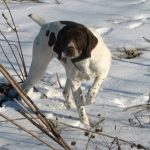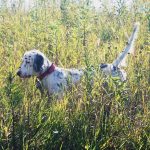POINTING DOG POINTERS: Leave Only Positive Prints
On a trip to Texas years back, we walked the beach at Padre Island and came upon a sign reminding visitors to “Leave Only Footprints.” When it comes to training your pointing dog, we’d take that directive and paraphrase it: Leave Only Positive Prints.
The imprint that we make on our pup as we train and develop him will be either positive or negative. How can we tell?
The pup that we’ve left our positive, light-handed print on during his development is a happy pup. He’s excited to go hunting. He’d ready and eager for new experiences. His tail is up, his eyes alert, ears poised. He hunts joyfully, using his good nose to the best advantage and pointing with intensity. He may be retrieving well or showing much interest in retrieving. Most of all, he loves birds.
The pup that has had a negative, heavy-handed imprint in his training is inhibited and seems to lack motivation. He may even be fearful. He’s not interested in birds, doesn’t point, and maybe he even avoids birds. He shows no desire to retrieve. Noise or different experiences scare him. He may flinch when being handled.
If you are new to training a pointing dog, the first step in your program will be to evaluate your pup. Is he a soft, biddable pup or a bold, extroverted fellow? Does he need more or less control to keep him safe and manageable? Is he readily open to new experiences or does he need time to check things out in his own way first? Take time to observe and learn about your pup’s personality and temperament and plan accordingly, always opting for the patient and positive approach to keep that joy within him.
The pointers below will help you stay on track as a positive, light-handed trainer.
Your Pup Will Let You Know!
It’s important to continue to evaluate as you train. Your pup will tell you by his actions and responses if something is wrong with your training methods. Watch for signs from your pup that you are moving too fast, such as a reluctance to go to the field, hanging by your side, and a lack of enthusiasm. Too much pressure on a young pup, trying to make him do things that he is not ready for yet, will result in his showing you by his actions: “I’ve had enough!”
On the flip side, your pup may be continually straining at the checkcord, running off on you, jumping in on birds, and giving you plenty of indication that it may be time to establish a foundation of gentle but firm control. Being a positive and light-handed trainer includes teaching your pup manners and restraint where it’s appropriate – although for young pups, tolerance is important – would you expect a kindergartener to remain quiet and still for long?
The Soft Touch Works Wonders
Praise and positive reinforcement let a pup know that he’s pleasing you, and this is something that all dogs respond to. They want to be our partners and companions. They thrive on being happy and confident. It’s up to us to show them clearly what we want, emphasizing the good performances and always ending our training on a positive note. Sessions for the young dog should be short and not overly repetitive. A couple of successful bird finds, points, and gun shots are plenty for one session.
Force and Fear are Never Options
Years ago, some methods of training bird dogs could be brutal. Although there were many trainers who did not fit that category, those that did often encountered problems. We’ve come a long way today with positive and gentle training methods leading the way to successful development of our pointing dogs. Let pups be pups and never instill fear into their association with birds and bird dog training! It’s been said that pups can do no wrong in their first year, and we support this wholeheartedly. Many potentially great dogs have been ruined by tough, heavy-handed training.
Know When to Back Up and Regroup
If your pup is showing indecision or insecurity in his training sessions, it’s time to back up a step or two, remembering that you may be moving too fast. A good trainer knows when it’s time to back up to a level of training that his pup is comfortable with, and to stay at that level until pup lets us know he’s ready to move on. This is particularly true during gun development, when you want to closely observe your pup’s reaction to increasing noise levels and be ready to “fall back” if necessary. Backing up and regrouping also applies to your personality as a trainer. There’s no room for anger and punishment in training – this can set you back weeks or months, or even longer. You want to have a fit mental and emotional attitude in training. Patience is key. Training takes time. If you feel yourself starting to lose your temper, quit training for that day and try to end on a positive note, however small.
Be Open to Change in Your Training Methods
There are many good ways to train a bird dog. As you research training methods, pick out the ones that emphasize positive, gentle reinforcement, patience and no timetable. If something is not working for you, there is likely another positive method of training that might work for your particular training issue.
Don’t Be Afraid to Ask for a Pro’s Advice
If you find yourself in a real bind, don’t be afraid to ask a professional trainer’s advice. Again, research first to learn what training methods the trainer uses. Many trainers are happy to answer a few questions over the phone, but keep in mind that they make their living training dogs and they don’t give out step by step instructions for you to follow. Sometimes, too, it is worth spending some money to have a professional trainer address a certain problem that you can’t solve.
Always Maintain the Positive Print on Your Pup’s Personality
In his book Snakefoot – The Making of a Champion, Robert G. Wehle, renowned pointer breeder, says, “I believe the dog comes into the world liking man and we likewise, which is unique among all other species.”
Our goal then, is to honor that love that our pup has for us, and to keep him happy and joyful as we develop him into the best bird dog he can be.
Maybe Jody’s brother John sums it up best. After years of raising and training pointers and setters, John kept an English setter pup named Pearl from his last litter six years ago – primarily because she was deaf. In developing Pearl, he found that he gained invaluable experience, knowledge, and insight from the challenge of training a deaf puppy. He and Pearl have a bond stronger than any he’s ever had with his other dogs. He says: “She’s top dog here . . . hunts, points, backs, and retrieves . . . this year on pheasants she came into her own. She never runs out of energy and when she looks at me, she looks into my soul to see what I’m thinking . . . she can read me like a book . . . like I keep saying, Pearl trained me.”
Remember, Leave Only Positive Prints.
Pointing Dog Pointers features monthly training tips by Bob and Jody Iler, who own Green Valley Kennels in Dubuque, Iowa. Bob and Jody have trained pointing dogs for over 35 years and have written many articles for Pointing Dog Journal.










